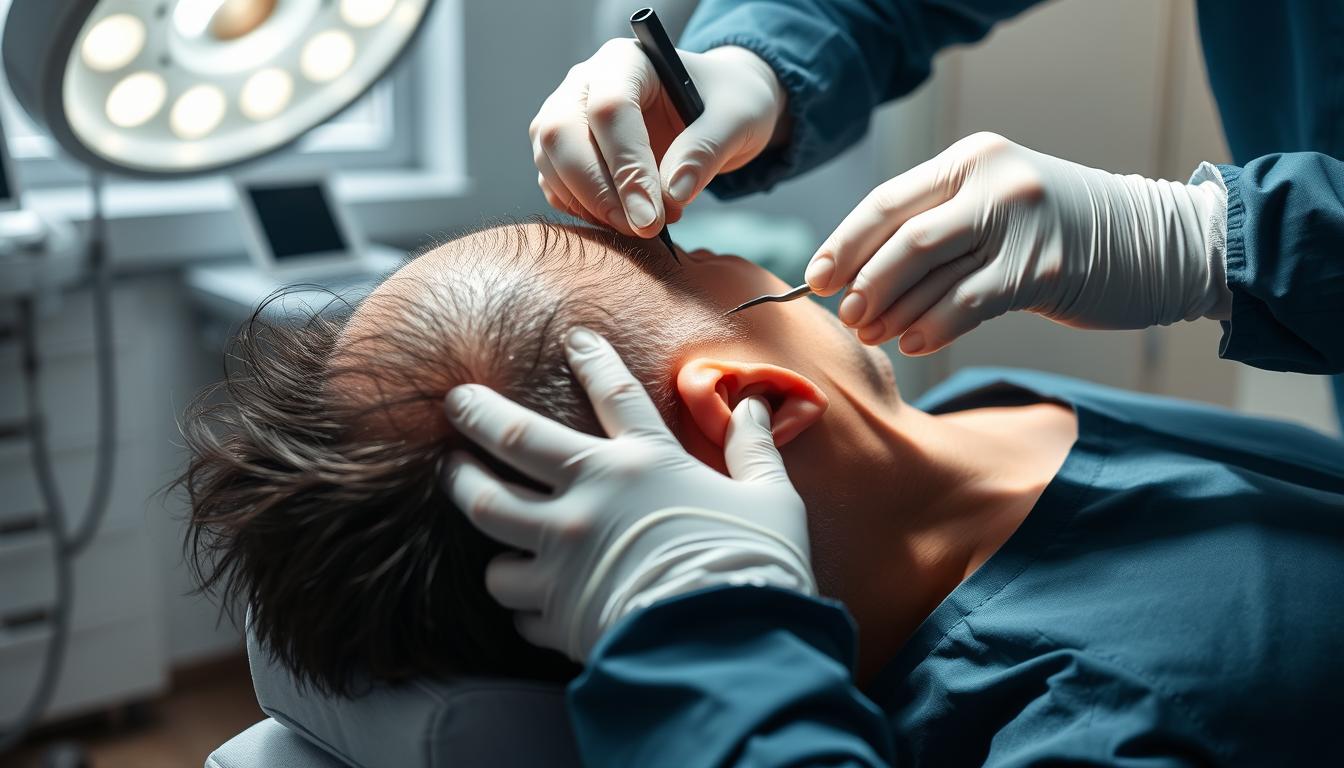Hair loss is a common issue affecting a significant portion of the population. Statistics show that at least 70% of men and 50% of women experience hair loss at some point in their lives. Losing 50-100 hairs daily is normal, but not everyone regrows them at the same rate.
Hair restoration has evolved significantly, offering effective solutions for those experiencing hair loss. Modern techniques provide natural-looking results with minimal downtime, making them increasingly popular.
Ontario is home to several specialized clinics offering state-of-the-art hair transplant procedures. Understanding the complete journey is essential for making informed decisions about addressing hair loss concerns.
Key Takeaways
- Modern hair transplant techniques offer natural-looking results.
- Ontario is home to several specialized hair restoration clinics.
- Hair transplant surgery can restore confidence and self-esteem.
- The procedure involves transplanting hair from one part of the scalp to another.
- Understanding the costs and expectations is crucial before undergoing the procedure.
Understanding Hair Loss and Restoration Options
The journey to addressing hair loss begins with understanding its causes and exploring available restoration options. Hair loss is a complex issue that can stem from a variety of factors, including genetics, hormonal changes, medical conditions, and environmental influences.
Common Causes of Hair Loss in Men and Women
Hair loss affects both men and women, though the prevalence and patterns can differ. Androgenetic alopecia, or male/female pattern baldness, is the most common cause, influenced by genetics and hormones. Other factors such as hormonal fluctuations during pregnancy or menopause, medical conditions like alopecia areata, and environmental stressors can also contribute to hair loss.
| Cause | Description | Impact on Hair |
|---|---|---|
| Genetics | Inherited trait influencing hair loss patterns | Permanent hair loss if untreated |
| Hormonal Changes | Fluctuations during pregnancy, menopause, etc. | Temporary or permanent hair loss |
| Medical Conditions | Alopecia areata, scalp infections, etc. | Variable patterns of hair loss |
When to Consider Professional Hair Restoration
Professional hair restoration should be considered when hair loss becomes noticeable and affects self-confidence or when over-the-counter treatments have proven ineffective. Early intervention often yields better results, particularly for progressive hair loss conditions. A consultation with a hair restoration specialist can help identify underlying causes and develop a personalized treatment plan, ranging from non-surgical treatments like medications and PRP therapy to surgical procedures such as FUE and FUT hair transplants.
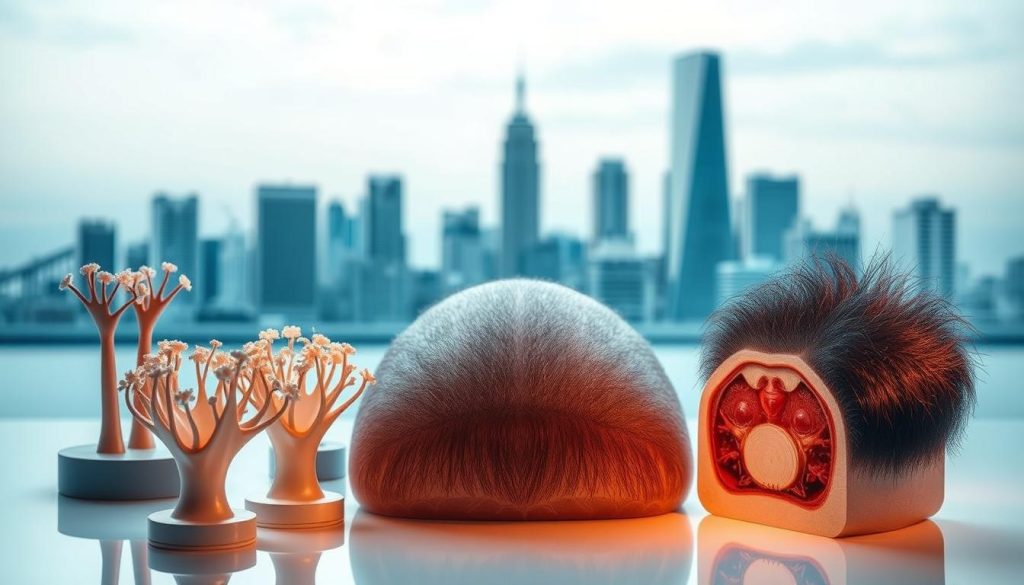
Hair Transplant in Ontario: Advanced Techniques and Technologies
Ontario is at the forefront of hair restoration, offering advanced techniques and technologies that have revolutionized the field. Hair transplant clinics in the region are equipped with state-of-the-art facilities and staffed by experienced surgeons who utilize the latest methods to provide patients with natural-looking results.

Follicular Unit Extraction (FUE) Method
The Follicular Unit Extraction (FUE) method has become a gold standard in hair transplantation. This technique involves extracting individual hair follicles from donor areas and transplanting them to balding regions. FUE is minimally invasive, resulting in virtually no visible scarring and allowing for a quicker recovery time compared to traditional methods.
During an FUE procedure, surgeons use specialized micro-punches to harvest individual follicular units containing 1-4 hairs, preserving their integrity for successful transplantation. The meticulous nature of FUE allows for custom hairline design and natural-looking density that blends seamlessly with existing hair.
Follicular Unit Transplantation (FUT) Method
Follicular Unit Transplantation (FUT), also known as the strip method, involves removing a strip of hair-bearing skin from the donor area, typically the back of the head. The FUT method can be advantageous for patients requiring extensive coverage, as it allows for the harvesting of a larger number of grafts in a single session.
While FUT leaves a linear scar, skilled surgeons in Ontario minimize its visibility, and it can be easily concealed with surrounding hair. Both FUE and FUT techniques have high success rates when performed by experienced surgeons, with the choice between them depending on individual factors such as the extent of hair loss and donor area characteristics.
Innovative Technologies Transforming Hair Restoration
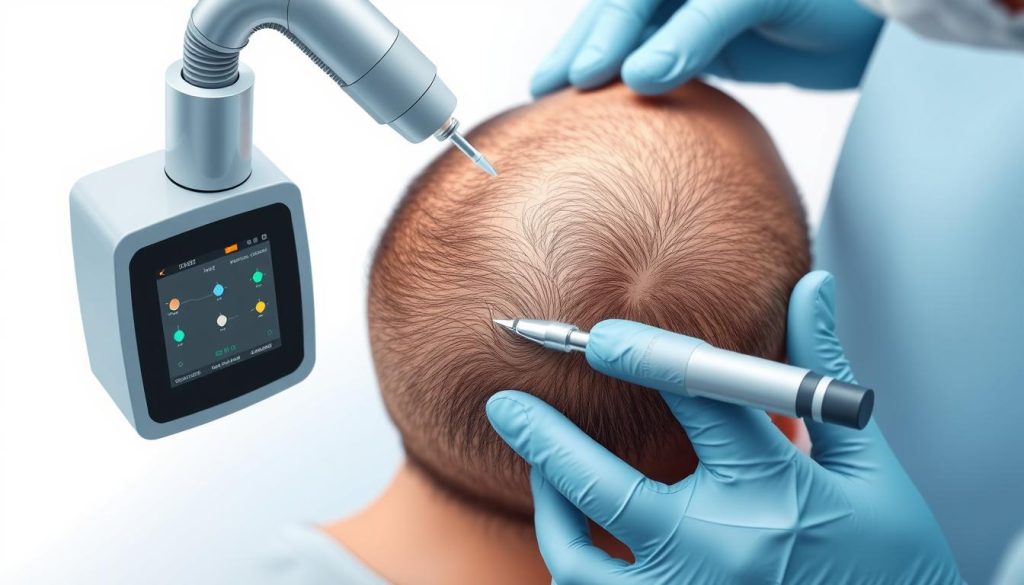
Innovative technologies are revolutionizing the field of hair restoration, offering enhanced precision and patient comfort. The introduction of advanced systems like NeoGraft and SmartGraft has significantly improved the hair transplant experience.
NeoGraft Automated Hair Transplant System
The NeoGraft system represents a significant advancement in automated FUE hair transplantation. It utilizes pneumatic pressure to extract follicular units with consistent quality and minimal trauma, reducing the risk of graft damage during extraction and implantation. This results in an impressive 94% take rate for transplanted follicles. NeoGraft’s automated approach allows for faster hair transplant procedures while maintaining high standards of precision, making it possible to transplant thousands of grafts in a single session.
SmartGraft Technology for Precision Results
SmartGraft technology further enhances the hair restoration experience by providing a closed, temperature-controlled environment that preserves graft viability throughout the procedure. The system’s built-in counting and sorting mechanisms help surgeons track and organize grafts, ensuring optimal placement for natural-looking results. Both NeoGraft and SmartGraft incorporate advanced harvesting techniques that minimize trauma to follicles, increasing survival rates and improving the overall quality of hair transplant results.
The combination of skilled surgical teams and these cutting-edge technologies has dramatically improved the consistency and naturalness of hair restoration results available in Ontario. By leveraging these innovative systems, clinics can offer minimally invasive procedures with reduced recovery times and virtually invisible scarring, enhancing the overall patient experience.
The Hair Transplant Procedure: What to Expect
For those considering hair restoration, knowing what to expect from the hair transplant procedure is essential. This knowledge helps in setting realistic expectations and understanding the process involved in achieving natural-looking hair restoration results.
Pre-Procedure Consultation and Planning
The journey to a successful hair transplant begins with a comprehensive consultation. During this initial phase, the surgeon evaluates the individual’s hair loss pattern, discusses their goals, and determines if they are an ideal candidate for the transplant procedure. Advanced digital imaging may be used to preview potential outcomes and help set realistic expectations.
- The surgeon assesses the individual’s hair loss and determines the optimal number of grafts needed.
- A customized treatment plan is designed, including the technique to be used and the expected timeline for results.
Step-by-Step Transplant Process
On the day of the hair transplant surgery, the process begins with the administration of local anesthesia to ensure comfort throughout the procedure, which typically lasts between 4 to 8 hours. The transplant procedure involves extracting grafts from the donor area and implanting them in the recipient area.
- For FUE procedures, individual follicular units are extracted using specialized micro-punches.
- The recipient area is prepared with tiny incisions made at specific angles and densities to match the natural hair growth pattern.
- The grafts are then meticulously placed into these incisions, with particular attention paid to the hairline design.
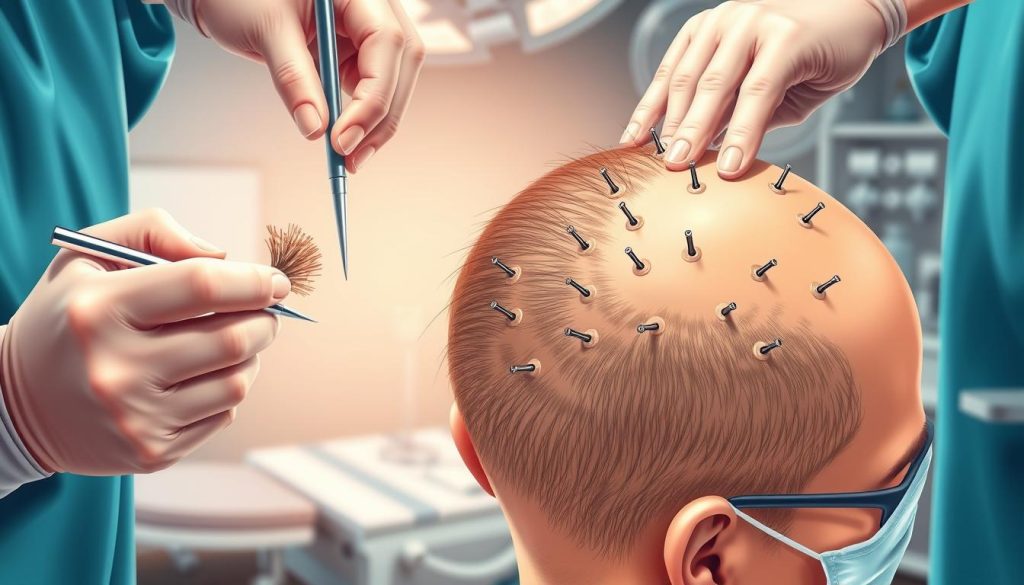
Post-Procedure Care Instructions
Post-procedure care is crucial for optimal results. Patients are given specific instructions for washing the scalp, avoiding certain activities, and medications to reduce swelling and discomfort. Most patients can return to work within 3 to 7 days, and the final results of the hair transplant develop gradually over 9 to 12 months.
- Patients are advised on how to care for their scalp post-procedure.
- Medications are prescribed to manage any discomfort or swelling.
Determining if You’re an Ideal Candidate
Determining candidacy for a hair transplant involves a comprehensive evaluation. At our hair transplant surgery clinic, we recommend waiting until hair loss has stabilized, typically around the mid-20s and beyond. This ensures the most effective and lasting results.
Age and Hair Loss Pattern Considerations
The stability of hair loss is one of the most important considerations for long-term success. Ideal candidates are typically individuals in their mid-20s or older who have experienced progressive hair loss but have stabilized patterns. The type and pattern of hair loss significantly impact candidacy, with androgenetic alopecia being the most common and successfully treated condition.
- Ideal candidates have stabilized hair loss patterns.
- Sufficient donor hair density is essential for successful transplantation.
Health Factors and Expectations
General health considerations play a crucial role, as certain medical conditions, medications, or lifestyle factors may affect healing and graft survival rates. Realistic expectations about results are vital for candidate selection. During the consultation, surgeons evaluate scalp flexibility, hair characteristics, and the contrast between hair and scalp to determine the potential aesthetic outcome.
- Patients should have realistic expectations about hair transplant results.
- Psychological readiness for the procedure is an important aspect of candidacy.
Cost of Hair Transplants in Ontario
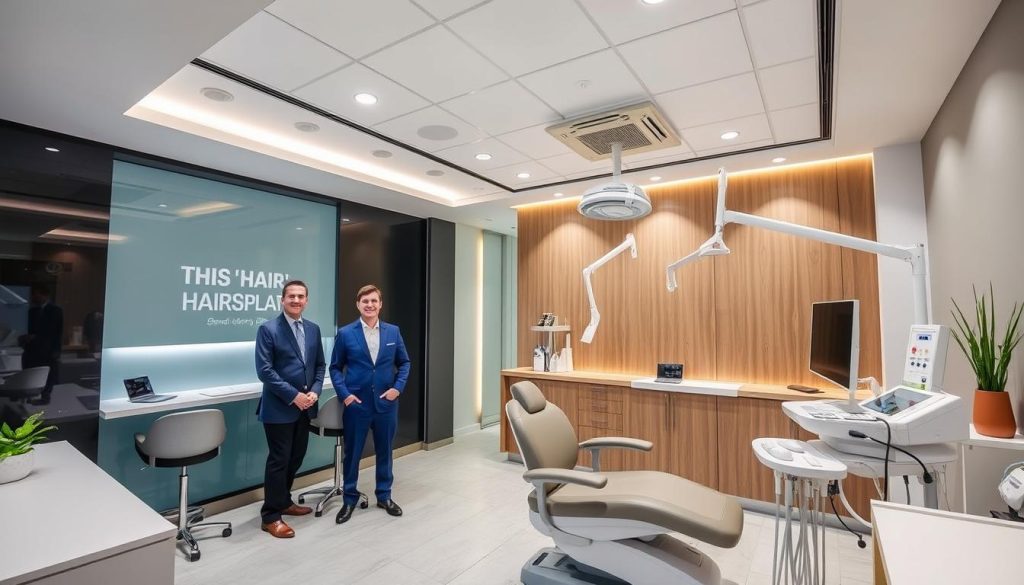
For individuals looking into hair transplants in Ontario, understanding the cost structure is crucial. The cost of hair transplants in this region can vary widely, typically ranging from $5,500 to $15,000.
Factors Affecting Hair Transplant Pricing
The final cost of a hair transplant is determined by several key factors specific to each patient’s needs. The number of grafts required is the primary cost determinant, with clinics in Toronto charging per graft, typically between $4 and $10 per graft.
The technique chosen, such as FUE or FUT, significantly impacts pricing. FUE procedures are generally more expensive due to their labor-intensive nature. Additional services like PRP therapy may also add to the base price.
Financing Options and Payment Plans
To make hair transplants more accessible, many Ontario clinics offer financing options with monthly payment plans. Some clinics provide zero down payment and interest-free periods, while others partner with third-party financing companies to offer flexible payment terms over 12-60 months.
At the Hair Transplant Medical Centre, for instance, financing options start at $76 bi-weekly with zero down payment, making the procedure more affordable for patients.
Choosing the Right Hair Transplant Clinic in Ontario

The success of a hair transplant procedure largely depends on the expertise of the clinic and the surgeon performing it. With numerous clinics offering hair restoration services in Ontario, it’s crucial to make an informed decision.
Qualifications to Look for in a Hair Transplant Surgeon
When selecting a hair transplant clinic, the qualifications and experience of the surgeon are paramount. Look for surgeons who are board-certified in relevant specialties such as dermatology or plastic surgery, or those with specific training and certification in hair restoration procedures. A surgeon’s experience with hair transplantation is critical, as those who have performed thousands of procedures typically develop the artistic eye and technical skill necessary for natural-looking results.
For instance, Dr. Sheldon Feld leads our team with over 20 years of experience exclusively focused on hair transplant surgery. Trained by world-renowned experts like Dr. Walter P. Unger, Dr. Feld has performed approximately 2,000 successful hair transplant procedures, totaling over 4,000,000 grafts. Such extensive experience and training are essential for achieving optimal results.
Questions to Ask During Your Consultation
During your consultation, it’s essential to ask detailed questions about the procedure. Inquire about who will perform each step of the transplant, as some clinics may have technicians rather than the surgeon performing crucial aspects. Discuss the clinic’s protocol for graft handling and preservation, as these factors significantly impact graft survival rates and overall results.
Additionally, ask about realistic expectations for your specific case, including potential coverage, the number of sessions needed, and the timeline for visible results. Understanding the clinic’s aftercare program is also vital, as proper post-procedure care and follow-up appointments contribute significantly to successful outcomes.
Take the First Step Toward Restoring Your Confidence
Taking the first step towards hair restoration can be daunting, but with the right clinic, it’s a journey worth taking. Whether you’re just beginning to explore hair transplant options or you’re ready to take the next step to treat your permanent hair loss, our team is here to help.
With clinics in Ontario, Toronto, Mississauga, and Oakville, expert hair restoration is just a call away. We offer free consultations via WhatsApp, phone, FaceTime, and Zoom, allowing you to receive a personalized treatment plan tailored to your goals and concerns.
Modern hair transplant procedures offer permanent solutions to hair loss, with results that continue to improve over time as transplanted follicles establish and begin producing healthy hair growth. The journey to restored confidence requires patience, as full results typically develop over 9-12 months following the procedure.
By choosing a qualified clinic in Ontario and committing to the process, you’re not just investing in hair restoration but in renewed confidence and a positive self-image that can impact all areas of your life. Schedule your free hair loss consultation now and take the first step towards a fuller set of hair.
FAQ
What is Follicular Unit Extraction (FUE) and how does it work?
FUE is a minimally invasive hair restoration technique where individual follicular units are extracted from the donor area and transplanted to the recipient area. This method leaves minimal scarring and promotes natural-looking results.
How long does it take to recover from a hair restoration procedure?
The recovery time varies depending on the individual and the technique used. Generally, patients can resume normal activities within a few days to a week after the procedure.
What are the benefits of choosing a clinic that uses advanced technologies like NeoGraft Automated Hair Transplant System?
Clinics that utilize advanced technologies like NeoGraft can offer more precise and efficient hair restoration results, minimizing the risk of human error and promoting a more natural appearance.
Can women undergo hair restoration procedures?
Yes, women can undergo hair restoration procedures. The suitability of the procedure depends on the individual’s hair loss pattern, overall health, and expectations.
How much does a hair transplant procedure cost?
The cost of a hair transplant varies based on factors such as the technique used, the number of grafts required, and the clinic’s location. Financing options and payment plans may be available.
What should I look for when choosing a hair transplant surgeon?
When selecting a hair transplant surgeon, consider their qualifications, experience, and before-and-after photos of previous patients to ensure they can meet your needs and expectations.
Are hair transplant results permanent?
Hair transplant results can be long-lasting, but the transplanted hair follicles may still be susceptible to future hair loss. Proper post-procedure care and follow-up treatments can help maintain the results.
